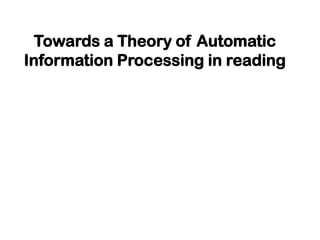
Reading presentation 1
- 1. Towards a Theory of Automatic Information Processing in reading
- 2. Some notions • The journey that words take from their written form to ther enentual activation of their meaning involves lots of stages of information processing. • The journey takes a very short time for fluent readers. • The acquisition of reading skills takes years.
- 3. Skills and attention • The excution of a complex skill necesitaes a coordination of many other many compenent processes within a very short of time. • The skill will not be excuted successfully if one of the component process requires attention. • If the compents and their coordinations can be processed automatically, the skill can be successfully performed.
- 4. Purpose • Present a model of reading process which describes the main stages invoved in transforming written pattern into meanings and relates the attention mechanism in processing at each of these stages. • Test this model against some experimental findings that claims that the role of attention changes during advanced states of perceptual and associative learning.
- 5. Main Sections of the Article I. A brief summary of the current views of the attention mechanism in information processing. II. Set forth a theory of automacity in reading and evaluate against some data. III. Discuss factors which may influence the development of automacity. IV. Discuss some implications of the model for research in reading instruction.
- 6. Attention Mechanism in Information processing • The properties of attention according to the researches in the recent past. • Selectivity and capacity limitation • Posner and Boies add another component of attention which is alterness ( this property has been investigated in vigilance tasks) • Limited capacity has generated the most theoretical controversy.
- 7. Previous Theories • Dichotic listening experiments: The subject select one ear at a time of processing massages.
- 8. The effects of attentional activation on information processing There are three effects: It can assist in the construction of a new code. ( in figure 1, successive activation of features f7 and f8 is necessary to synthesize letter code L5. Activation of a code prior to the presentation of its corresponding stimulus is assumed to increase the rate of processing when that stimuls is presented. Activation of a code can arouse other codes to which it has been associated.
- 9. Example • Suppose a child is learning to discriminate the letters t and h. in this case: • The length of the vertical line is not relevant to the discrimination of the two letters. • Instead, he must notice the short horizontal cross of t and the concave loop in the h. • These are the distinctive features of these letters when considered against each other. • One feature which seems irrelevant for all letters is thickness of line. • Letters share features in common.
- 10. • The rate of learning to select the appropriate bfeatures of a pattern may be quite slow the first time a child is given letters to discriminate.
- 11. The second stage of perceptual learning • During this stage, the subject must a letter code from the relevant features, a process that needs attention. • First, the subject scans, rapidly, the idividual feature detectors and strats to form high- order unit. • If the pattern has too many features, organistaion into a unit code might not be manageable.